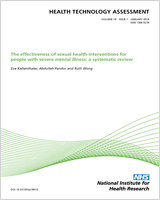Included under terms of UK Non-commercial Government License.
NCBI Bookshelf. A service of the National Library of Medicine, National Institutes of Health.
Sharples L, Glover M, Clutterbuck-James A, et al. Clinical effectiveness and cost-effectiveness results from the randomised controlled Trial of Oral Mandibular Advancement Devices for Obstructive sleep apnoea–hypopnoea (TOMADO) and long-term economic analysis of oral devices and continuous positive airway pressure. Southampton (UK): NIHR Journals Library; 2014 Oct. (Health Technology Assessment, No. 18.67.)

Clinical effectiveness and cost-effectiveness results from the randomised controlled Trial of Oral Mandibular Advancement Devices for Obstructive sleep apnoea–hypopnoea (TOMADO) and long-term economic analysis of oral devices and continuous positive airway pressure.
Show detailsDuring the course of the trial, three substantial amendments to the protocol were submitted to, and subsequently approved by, the Research Ethics Committee (REC).
Substantial amendment 1, dated 6 December 2010 and reviewed 20 December 2010 included:
- Change of investigator at Addenbrooke’s maxillofacial laboratory.
- Clarification of inclusion and exclusion criteria.
- Sections on degree of protrusion and randomisation added to the study plan.
- Clarification of timelines.
- Outcome measures updated.
- Strengths and limitations added as a response to peer-review comments.
- Clarification of adverse event reporting.
- Updating of patient information sheet and patient diaries.
Substantial amendment 2, dated 1 June 2012 and reviewed 26 June 2012 included:
- Increasing number of participants randomised from 90 to a maximum of 96.
- Longer-term follow-up at 1 year and 2 years post-trial completion.
- Extension of current trial end date.
- Minor changes throughout protocol for clarification purposes.
Substantial amendment 3, dated 19 September 2012 and reviewed 16 October 2012 included:
- Removal of a contact from the protocol.
- Change to FOSQ questionnaire.
- Change to sponsor contact.
- Change to follow-up questionnaire.
A fourth substantial amendment was approved by the REC, but the amendment applied to the follow-up questionnaire alone and not the protocol. Substantial amendment 4, dated 1 May 2013 and reviewed 27 May 2013 included:
- Adding an extra question to the follow-up up questionnaire.
- Summary of protocol changes - Clinical effectiveness and cost-effectiveness resu...Summary of protocol changes - Clinical effectiveness and cost-effectiveness results from the randomised controlled Trial of Oral Mandibular Advancement Devices for Obstructive sleep apnoea–hypopnoea (TOMADO) and long-term economic analysis of oral devices and continuous positive airway pressure
- Grading the quality of evidence for the primary and clinically important outcome...Grading the quality of evidence for the primary and clinically important outcomes for the effectiveness of mixed approach interventions in pregnancy - Interventions to Reduce or Prevent Obesity in Pregnant Women: A Systematic Review
- References - Treatments for hyperemesis gravidarum and nausea and vomiting in pr...References - Treatments for hyperemesis gravidarum and nausea and vomiting in pregnancy: a systematic review and economic assessment
- Changes to protocol - Feasibility of in-home monitoring for people with glaucoma...Changes to protocol - Feasibility of in-home monitoring for people with glaucoma: the I-TRAC mixed-methods study
- Adverse event specific tables - Clinical effectiveness and cost-effectiveness re...Adverse event specific tables - Clinical effectiveness and cost-effectiveness results from the randomised controlled Trial of Oral Mandibular Advancement Devices for Obstructive sleep apnoea–hypopnoea (TOMADO) and long-term economic analysis of oral devices and continuous positive airway pressure
Your browsing activity is empty.
Activity recording is turned off.
See more...